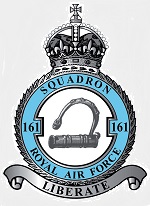Corgi AA36810 RAF Westland Lysander Mk. IIIA Reconnaissance Aircraft - 'Lucky' Newhouse, No.161 Squadron, Tangmere, England, June 1944 (1:72 Scale)
"Never in the field of human conflict was so much owed by so many to so few."
- British Prime Minister Winston Churchill, commenting on the British airmen in the Battle of Britain
 The Westland Lysander (nickname the "Lizzie") is a British army co-operation and liaison aircraft produced by Westland Aircraft used immediately before and during the Second World War. After becoming obsolete in the army co-operation role, the aircraft's exceptional short-field performance enabled clandestine missions using small, improvised airstrips behind enemy lines to place or recover agents, particularly in occupied France with the help of the French Resistance. British Army air co-operation aircraft were named after mythical or historical military leaders; in this case the Spartan admiral Lysander was chosen.
The Westland Lysander (nickname the "Lizzie") is a British army co-operation and liaison aircraft produced by Westland Aircraft used immediately before and during the Second World War. After becoming obsolete in the army co-operation role, the aircraft's exceptional short-field performance enabled clandestine missions using small, improvised airstrips behind enemy lines to place or recover agents, particularly in occupied France with the help of the French Resistance. British Army air co-operation aircraft were named after mythical or historical military leaders; in this case the Spartan admiral Lysander was chosen.
In 1934, the Air Ministry issued Specification A.39/34 for an army co-operation aircraft to replace the Hawker Hector. Initially, Hawker Aircraft, Avro and Bristol were invited to submit designs, but after some debate within the ministry, a submission from Westland was invited as well. The Westland design, internally designated P. 8, was the work of Arthur Davenport under the direction of "Teddy" Petter. It was Petter's second aircraft design and he spent considerable time interviewing Royal Air Force pilots to find out what they wanted from such an aircraft. The army wanted a tactical and artillery reconnaissance aircraft to provide photographic reconnaissance and observation of artillery fire in daylight -- up to about 15,000 yards (14 km) behind the enemy front. The result of Petter's pilot enquiries suggested that field of view, low-speed handling characteristics and STOL performance were the important requirements.
Westland Lysander Mk.III (SD) in overall black camouflage as used for special night missions into occupied France during World War II.
Davenport and Petter designed an aircraft to incorporate these features. The Lysander was to be powered by a Bristol Mercury air-cooled radial engine and had high wings and a fixed conventional landing gear mounted on an innovative inverted U square-section tube that supported wing struts at the apex, and contained internal springs for the faired wheels. The large streamlined spats also contained a mounting for a Browning machine gun and fittings for removable stub wings that could carry light bombs or supply canisters. The wings had a reverse taper towards the root, which gave the impression of a bent gull wing from some angles, although the spars were straight. It had a girder type construction faired with a light wood stringers to give the aerodynamic shape. The forward fuselage was duralumin tube joined with brackets and plates, and the after part was welded stainless steel tubes. Plates and brackets were cut from channel extrusions rather than being formed from sheet steel. The front spar and lift struts were extrusions. The wing itself was fabric covered and its thickness was greatest at the strut anchorage, similar to that of later marks of the Stinson Reliant high-winged transport monoplane.
Pictured here is a 1:72 scale replica of a RAF Westland Lysander Mk. IIIA(SD) reconnaissance aircraft that was piloted by 'Lucky' Newhouse, who was attached to No.161 Squadron during , June 1944.
Now in stock!
Dimensions:
Wingspan: 8-1/4-inches
Length: 5-1/4-inches
Release Date: September 2024
 Historical Account: "Spy Shuttle" - In the months leading up to and just after D-Day, the Westland Lysanders of RAF No.161 Squadron made a significant, yet largely unheralded contribution towards the success of this massive Allied operation. Flying incredibly perilous clandestine 'Spy Shuttle' operations, unarmed Lysanders were flown on nights where they could rely on the light of the moon, carrying up to three agents, or 'operatives', into enemy occupied France and often bringing others back on the return flight. These operations were vital in providing the Allies with intelligence information and disrupting German activities right across Europe but were incredibly perilous for those involved particularly as they were taking place right under the noses of the Germans.
Historical Account: "Spy Shuttle" - In the months leading up to and just after D-Day, the Westland Lysanders of RAF No.161 Squadron made a significant, yet largely unheralded contribution towards the success of this massive Allied operation. Flying incredibly perilous clandestine 'Spy Shuttle' operations, unarmed Lysanders were flown on nights where they could rely on the light of the moon, carrying up to three agents, or 'operatives', into enemy occupied France and often bringing others back on the return flight. These operations were vital in providing the Allies with intelligence information and disrupting German activities right across Europe but were incredibly perilous for those involved particularly as they were taking place right under the noses of the Germans.
One of the most unusual Lysanders to ever take part in these famous clandestine operations, this aircraft was flown by pilot 'Lucky' Newhouse and sported D-Day identification markings around its rear fuselage, but significantly, not on its wings. A rather unique aircraft, squadron records show that Newhouse flew this Lysander for the first time on the night of August 4th, 1944, during 'Operation Scimitar', where he landed in France delivering three agents, bringing back another three on the return flight back to England. Even with the addition of D-Day markings, these nocturnal Lysanders were unusual in that they often came under fire from both enemy and friendly forces, so secretive were their important missions.


